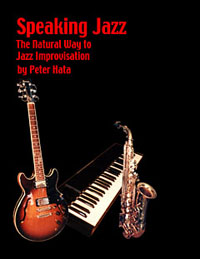Speaking Jazz: The Natural Way to Jazz Improvisation
|
Transcribed Solos
|
About Peter Hata
(bio and playing samples)
|
Speaking Jazz Endorsements:
"Peter Hata has provided the global music community with a book that thoroughly and clearly outlines the tasks involved in the art of harmonic jazz improvisation. The examples are beautifully constructed and to the point, and the text is straightforward and unfettered by technical jargon. Speaking Jazz deserves to be at the top of any improviser's method book list."
-Larry Koonse, Instructor of Jazz Guitar at California Institute of the Arts
"I have studied music theory for many years and have shelves filled with jazz books and reprints from the internet. I just have to write and tell you that Speaking Jazz is the very best--the very best--of its kind in my entire collection. You put a lot of time and personal dedication into creating this, and I want to let you know that it was all for the benefit of those who love the art of jazz. I have made huge strides in my playing. I'm in a weekly jazz workshop with a number of players at the Eastman School here in Rochester, NY, and I can already hear a new approach in my solos. This is like finding the holy grail. Thanks for the inspiration."
Phil St.George, NY
"I just wanted to take a moment and let you know that I got my book and I am very happy with it. I just wish that I had this book a long time ago and I would be better because of it. Through the years I have bought so many very good Bebop and Jazz books and it didn't take long to find out that Speaking Jazz stands way out front and center and way beyond all of these books put together. It is well worth much more than the $34.95. Thank You Peter for all of your hard work and dedication that you put into this very rare and wonderful book called Speaking Jazz."
Rick Coker, TX
"This book has helped me more than any other book I have...This book has shown me how to keep the chord tones on the downbeats and how to connect arpeggios, intervals, scales along with enclosure, deflection, and forward motion (paying off the V7 chord over a static minor II7 vamp). I now have a better understanding of how Benson and Martino play those long flowing runs that never seem to end."
Lee Woods, CA
I received the book today and literally spent 5 hours going through it. I have tons of books on jazz guitar improvising, but this is an incredible book. Maybe for some beginners the book may go over their head and they won't realize the beauty of how you laid it all out. It wasn't until I took your short lines and started developing and adding and pre-hearing the lines that my playing started sounding not just like random noodling on the blues scale and mixolydian. Also, for years, practicing the modes had confused me. But the clarity of your book opened a door of deeper understanding. I know if I put in the time and effort, with this book I'm going to finally crack the jazz code.
Willie Stephens, IL
|

www.allaboutjazz.com
(Peter Hata's Southern California Teaching Info)
|

Member, California Alliance for Jazz
|

Member, College Music Society |
|
What does it mean to "speak jazz?"
“Speaking jazz” simply means to speak the language of jazz or, in other words, to improvise jazz. What is jazz? Jazz comes in many varieties, but the “mainstream” of jazz has historically been defined as being based on or heavily influenced by bebop. Here's an example of the bebop-based jazz language—listen to the mp3 audio example and examine its notation below:
Speaking Jazz Ex. 1
 |
If we analyse the above 8 bar example, we find several jazz devices and phrases:
1) The ascending D dorian scale skips the 6th tone, a commonly used jazz phrase or fragment.
2) The chromatic approach to the note B (3rd of the G7) is a standard jazz device.
3) The ascending diminished arp off the 3rd of the G7 is another standard device.
4) The same enclosure is used to approach the 3rd of the Cmaj7.
There are similar phrases and devices in the second half of the example as well. |
|
Speaking Jazz: The Natural Way to Jazz Improvisation
This book presents a complete approach to jazz improvisation based on the authentic jazz phrases and devices from solos by saxophonists Charlie Parker and John Coltrane, trumpeters Clifford Brown and Freddie Hubbard, guitarists Wes Montgomery and George Benson, and many others. This approach to jazz improvisation arose naturally out of my transcription and study of many solos of these jazz greats. I realized that a great deal of their soloing was actually comprised of certain phrases that they used over and over again. For example, instead of looking at the musical example above as an “8 bar bebop solo,” using a phrase-based approach, it can be seen more clearly as a series of short phrases. The shortness of these phrases makes them easy to remember and use. In this sense, studying phrases can be more powerful than studying transcriptions alone. Once internalized, phrases can be used like “building blocks” to create endless solo variations of your own. This is a large part of what improvising jazz involves—not creating things completely “out of the blue,” but using already learned phrases. It’s like learning a foreign language—we don’t suddenly and miraculously “just start speaking” in long complex sentences; we start by learning short phrases and putting them together to make longer, more complex statements. Hence the title, “Speaking Jazz”: jazz improvisation should be as natural as speaking.
|
 |
Features of Speaking Jazz, Second Edition
-The phrase-based approach is easy to get started with, yet also virtually unlimited in scope.
-This book teaches the crucial diatonic, melodic minor and diminished harmony necessary to apply these phrases to standards and jazz tunes. In addition, the second edition has been extensively edited and features expanded material on diminished harmony.
-You’ll learn how to solo on all the common progressions in jazz, including all varieties of major and minor II-V-I progressions, rhythm changes and jazz blues.
-There are complete solos on core jazz tunes like “Tune Up,” “Just Friends,” “There Will Never Be Another You” and “Autumn Leaves,” which clearly illustrate how to put it all together and create a complete solo.
-Besides standard musical notation, the book features “number notation,” a new kind of universal and practical notation that goes hand-in-hand with the phrase-based approach.
-The unique and effective approach in Speaking Jazz starts by teaching authentic minor bebop phrasing over dorian vamps like those commonly found in “modal jazz tunes” such as Miles Davis’ “So What,“ Freddie Hubbard’s “Little Sunflower,” or Herbie Hancock’s “Chameleon.” The book then teaches how to apply minor phrasing to the chords of melodic minor and diminished harmony. This powerful concept is also known as minor conversion.
-159 pages, with major sections on Diatonic Harmony, the Bebop-Dorian Scale, Melodic Minor Harmony and Diminished Harmony.
-Well over 200 examples, exercises, solos
-Special sections on “How to Transcribe Solos,” “Band-in-a-Box,” “Jazz Core Tunes,” and “How to Apply the Book to Guitar” (using the “CAGED Forms” and the “Tonic Form System”). By the way, these few guitar-specific pages are really “fretboard-specific”; guitar and bass present some unique fretboard-related challenges. However, the book is not guitar-specific; the improvisation examples in Speaking Jazz fall within the written range of most instruments (middle C to about F above double-high C), and the Introduction shows how to apply examples to saxophone, trumpet, and other transposing instruments. And, as mentioned above, the phrases of Speaking Jazz were derived from a diverse selection of jazz greats, including saxophonists, trumpeters, and others.
-Fully referenced Index
-Professionally printed, high-quality spiral-bound book
-Page samples : 1) Table of Contents (pdf) 2) Sample from diatonic harmony 3) Sample from melodic minor harmony 4) Sample from “More Chords” (discussing diminished harmony; includes sample of number notation) 5) Index (pdf); please note that Speaking Jazz is printed on a high-res laser printer, but for the web, these samples are scanned at a low-res 100 dpi.
If you would like to buy Speaking Jazz and live in the U.S.A., please click the PayPal button in the left column. If you live outside the U.S.A., please click the button in the right column.
|
If you live in the U.S.A. |
If you live outside the U.S.A.
(price includes international handling) |
Cost of Speaking Jazz:
|
$34.95 |
$43.95 |
| Shipping cost: |
$8.00
(USPS Priority Mail; usually 2-3 days to any location in the U.S.A.) |
$8.00
(USPS Air Mail, usually arrives within 7 days) |
| Total Cost: |
$42.95 |
$51.95 |
Buy Speaking Jazz:
(Secure transaction hosted by PayPal.com) |
|
|
When you order, usually within 1 business day of receiving payment notification, I will ship your book in a secure envelope and send you an e-mail receipt with USPS Delivery Confirmation tracking number (or U.S. Customs Barcode for International orders).
Since 2001, I have shipped many copies of Speaking Jazz throughout the U.S.A. and internationally to Europe, Scandinavia, Asia, Australia, South America, and Canada. There have been no complaints. Instead, there have been many endorsements like those seen in the left hand column. If you look at the page samples above, you will see that, although learning to improvise jazz is not exactly “easy,” this book provides the necessary guidance in a very clear, well-written, step-by-step way. If you sincerely want to improvise jazz—if you truly love jazz—my book, Speaking Jazz, will definitely help you get there!
Best Wishes,
Peter Hata
pkhata@speakingjazz.com
|
© 2001-2025 Peter K. Hata
|
|
|